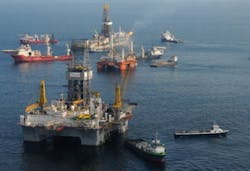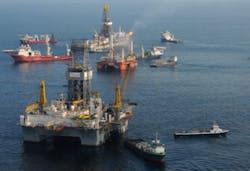BP PLC crews drilling the first relief well to the Macondo well tentatively planned to start trying to kill the flow of oil and gas inside Macondo around Aug. 7-9 regardless of the success of a static kill operation, expected around Aug. 2. Tropical weather or technical problems could delay the anticipated timeline.
National Incident Commander and retired US Coast Guard Adm. Thad Allen said a final 2,000-ft casing needed to be in place for the relief well before crews could start the static kill at the top of the well.
"At that point, we will be ready to move on to do two things. First of all, we will then shift to pumping mud and cement down the top of the well," Allen said. The static kill is intended to fill the inside of the well with mud and then cement using choke and kill lines on the failed Deepwater Horizon blowout preventer. The Helix Q4000 multiservice vessel will pump mud and cement.
Kent Wells, BP executive vice-president of exploration and production, said the static kill potentially could kill the flow of oil and gas in the Macondo well, but that BP still plans to complete the relief well.
Allen estimated the relief well crews could start trying to kill Macondo from the bottom of the well around Aug. 7-9. The relief well first will be drilled into the annulus of Macondo where crews will set cement. Then, crews plan to drill the relief well into the casing of Macondo.
Wells previously estimated that it could take the relief well crew anywhere from days to weeks to permanently seal the bottom of the Macondo well.
Well capped
Macondo remained shut in with a sealing cap on it while most spill response vessels were evacuated for tropical weather. Transocean Ltd.'s Development Driller III semi was back at the Macondo site on July 24 after Tropical Storm Bonnie was downgraded to a tropical depression as it crossed the gulf.
The semi drilling the second relief well, Development Driller II, also was moved back into position and was reconnected with a second relief well. "However, work on the second relief well has been suspended so as not to interfere with the first," BP said.
At least one remotely operated vehicle remained at the site where an Apr. 20 blowout resulted in an explosion and fire that killed 11 people on the Deepwater Horizon semi, which drilled the Macondo well for BP and its partners.
Allen said pressure readings taken inside the sealing cap continue to indicate well integrity. A seismic survey vessel, the Gecko Topaz, completed a seismic run on July 25 and detected no anomalies.
"The stack pressure has gone above 6,900 psi and currently stands at 6,904 psi," Allen told reporters on July 25. The sealing cap was installed on July 15 for the start of a well integrity test. The well was monitored using various tools, including hydrophones and geophones.
More Oil & Gas Journal Current Issue Articles
More Oil & Gas Journal Archives Issue Articles
View Oil and Gas Articles on PennEnergy.com


